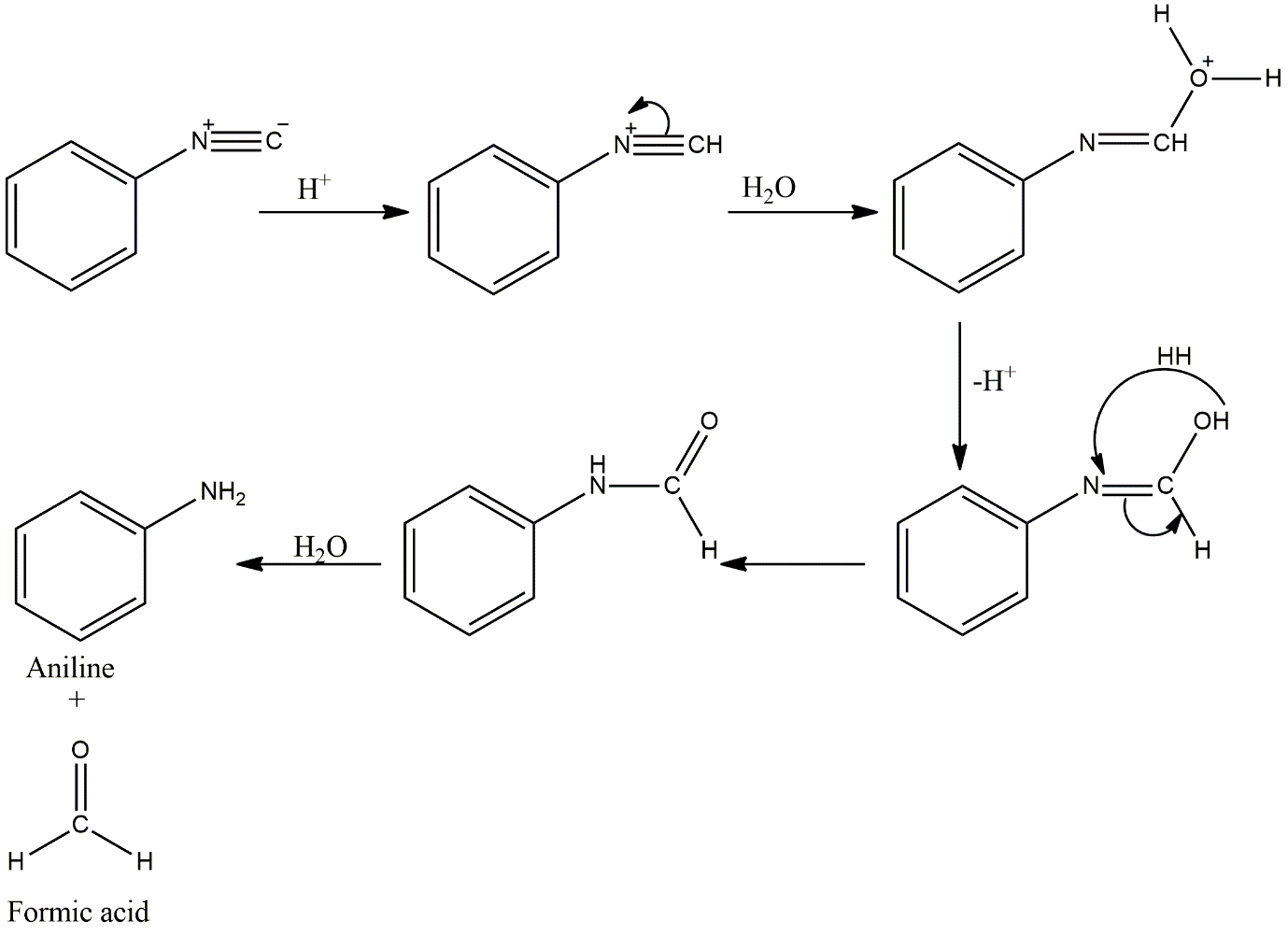
Which one doesn't liberate \[N{H_3}\] when undergoing hydrolysis?
A. Acetanilide
B. Acetonitrile
C. Acetamide
D. Phenyl isocyanide
Answer
127.8k+ views
Hint: Hydro means water and lysis mean splitting, which means the hydrolysis reaction works with water. Here water splits into hydronium ions (protons) and hydroxyl ions, which are then attached to another molecule of the system.
Complete Step by Step Solution:
For this, a hydrolysis reaction should be done to check which one is liberating ammonia. The above options are having different functional groups, so all may have different steps of reactions.

Image: Hydrolysis reactions
After hydrolysis, only phenyl isocyanide is not liberating ammonia. Instead, it has formic acid as a by-product. And also, it requires an acidic condition for hydrolysis. This is because they both are charged. So, they need an acidic condition to accelerate the reaction.
So, the option D is correct.
Additional Information: Acetanilide and acetamide, both are having amide functional groups. Their carbon is more electrophilic because of electronegative atoms adjacent to it. On hydrolysis, hydroxyl ions will attach to this carbon. And hydronium ions to the nitrogen of amide functional group as it is electronegative. This results in breaking the bond between carbon and nitrogen of the amide functional group. Similar steps apply to acetonitrile. Acetonitrile has a cyanide functional group. There is again an electronegativity difference between carbon and nitrogen which will help in hydrolysis.
Note: Complete knowledge of hydrolysis is necessary. For ease, try memorising the functional groups and the generated electronegativity difference. This will help in reactions to understand which bond is susceptible to break.
Complete Step by Step Solution:
For this, a hydrolysis reaction should be done to check which one is liberating ammonia. The above options are having different functional groups, so all may have different steps of reactions.

Image: Hydrolysis reactions
After hydrolysis, only phenyl isocyanide is not liberating ammonia. Instead, it has formic acid as a by-product. And also, it requires an acidic condition for hydrolysis. This is because they both are charged. So, they need an acidic condition to accelerate the reaction.
So, the option D is correct.
Additional Information: Acetanilide and acetamide, both are having amide functional groups. Their carbon is more electrophilic because of electronegative atoms adjacent to it. On hydrolysis, hydroxyl ions will attach to this carbon. And hydronium ions to the nitrogen of amide functional group as it is electronegative. This results in breaking the bond between carbon and nitrogen of the amide functional group. Similar steps apply to acetonitrile. Acetonitrile has a cyanide functional group. There is again an electronegativity difference between carbon and nitrogen which will help in hydrolysis.
Note: Complete knowledge of hydrolysis is necessary. For ease, try memorising the functional groups and the generated electronegativity difference. This will help in reactions to understand which bond is susceptible to break.
Recently Updated Pages
Difference Between Vapor and Gas: JEE Main 2024

Area of an Octagon Formula - Explanation, and FAQs

Difference Between Solute and Solvent: JEE Main 2024

Absolute Pressure Formula - Explanation, and FAQs

Carbon Dioxide Formula - Definition, Uses and FAQs

Charle's Law Formula - Definition, Derivation and Solved Examples

Trending doubts
JEE Main 2025 Session 2: Application Form (Out), Exam Dates (Released), Eligibility & More

JEE Main Login 2045: Step-by-Step Instructions and Details

JEE Main Exam Marking Scheme: Detailed Breakdown of Marks and Negative Marking

JEE Main 2023 January 24 Shift 2 Question Paper with Answer Keys & Solutions

JEE Mains 2025 Correction Window Date (Out) – Check Procedure and Fees Here!

JEE Main Participating Colleges 2024 - A Complete List of Top Colleges

Other Pages
JEE Advanced Marks vs Ranks 2025: Understanding Category-wise Qualifying Marks and Previous Year Cut-offs

NCERT Solutions for Class 12 Chemistry Chapter 6 Haloalkanes and Haloarenes

NCERT Solutions for Class 12 Chemistry Chapter 1 Solutions

NCERT Solutions for Class 12 Chemistry Chapter 2 Electrochemistry

NCERT Solutions for Class 12 Chemistry Chapter 8 Aldehydes Ketones and Carboxylic Acids

NCERT Solutions for Class 12 Chemistry Chapter 7 Alcohol Phenol and Ether




